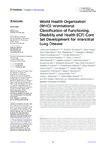World Health Organization (WHO) International Classification of Functioning, Disability and Health (ICF) Core Set Development for Interstitial Lung Disease
| dc.contributor.author | Saketkoo, LA | |
| dc.contributor.author | Escorpizo, R | |
| dc.contributor.author | Varga, J | |
| dc.contributor.author | Keen, KJ | |
| dc.contributor.author | Fligelstone, K | |
| dc.contributor.author | Birring, SS | |
| dc.contributor.author | Alexanderson, H | |
| dc.contributor.author | Pettersson, H | |
| dc.contributor.author | Chaudhry, HA | |
| dc.contributor.author | Poole, JL | |
| dc.contributor.author | Regardt, M | |
| dc.contributor.author | LeSage, D | |
| dc.contributor.author | Sarver, C | |
| dc.contributor.author | Lanario, Joseph | |
| dc.contributor.author | Renzoni, E | |
| dc.contributor.author | Scholand, MB | |
| dc.contributor.author | Lammi, MR | |
| dc.contributor.author | Kowal-Bielecka, O | |
| dc.contributor.author | Distler, O | |
| dc.contributor.author | Frech, T | |
| dc.contributor.author | Shapiro, L | |
| dc.contributor.author | Varju, C | |
| dc.contributor.author | Volkmann, ER | |
| dc.contributor.author | Bernstein, EJ | |
| dc.contributor.author | Drent, M | |
| dc.contributor.author | Obi, ON | |
| dc.contributor.author | Patterson, KC | |
| dc.contributor.author | Russell, A-M | |
| dc.date.accessioned | 2023-01-09T14:00:36Z | |
| dc.date.issued | 2022-10-14 | |
| dc.identifier.issn | 1663-9812 | |
| dc.identifier.issn | 1663-9812 | |
| dc.identifier.uri | http://hdl.handle.net/10026.1/20150 | |
| dc.description.abstract |
Background: The World Health Organization (WHO) introduced the International Classification of Functioning, Disability, and Health (ICF) as a scientific method of disability data collection comprised of >1,200 categories describing the spectrum of impairment types (functional, symptoms-based and anatomical) under the bio-psycho-social model with consideration of environmental and personal factors (pf). ICF Core Sets and ICF Checklists are streamlined disease-specific resources for clinical use, service provision, and for use in health economics and health policy. ICF can disclose strengths and weaknesses across multiple patient-reported outcome measures (PROMs) and help consolidate best-fitting question-items from multiple PROMs. Interstitial lung diseases (ILDs), are generally progressive, with restrictive physiology sometimes occurring in the context of multi-organ autoimmunity/inflammatory conditions such as connective tissue diseases (CTDs). In spite of significant associated morbidity and potential disability, ILD has yet to be linked to the ICF.Methods: Each instrument and their question-items within the consensus-recommended core sets for clinical trials in ILD were deconstructed to single concept units, and then linked per updated ICF linkage rules. Inter-linker agreement was established. Three additional subsequently validated measures were also included.Results: One-hundred-eleven ICF categories were identified for ten PROMs and three traditional objective measures that were amenable to ICF linkage. The proportion of agreement ranged from 0.79 (95% CI: 0.62, 0.91) to 0.93 (0.76, 0.99) with the overall proportion of inter-linker agreement being very high 0.86 (0.82, 0.89) for the initial instruments, with 94–100% for the three additional PROMs. Thirty-four new ‘Personal Factors’ emerged to capture disease-specific qualities not elsewhere described in ICF, e.g. ‘pf_embarrassed by cough’ or ‘pf_panic/afraid when can’t get a breath’.Conclusion: This first known effort in ICF linkage of ILD has provided important revelations on the current utility of the ICF in lung disease. Results have indicated areas for meaningful assessment of ICF descriptors for lung impairment. The mapping across PROMs provides insight into possibilities of developing more streamline and precise instrumentation. Finally, familiarity with the ICF in ILD may enable clinicians to experience a smoother transition with the imminent harmonization of ICD and ICF, ICD-11. | |
| dc.format.extent | 979788- | |
| dc.format.medium | Electronic-eCollection | |
| dc.language | eng | |
| dc.language.iso | eng | |
| dc.publisher | Frontiers Media SA | |
| dc.rights | Attribution 4.0 International | |
| dc.rights.uri | http://creativecommons.org/licenses/by/4.0/ | |
| dc.subject | CTD-ILD | |
| dc.subject | ICD-11 | |
| dc.subject | connective tissue | |
| dc.subject | cough | |
| dc.subject | fibrosis | |
| dc.subject | patient-reported outcomes | |
| dc.title | World Health Organization (WHO) International Classification of Functioning, Disability and Health (ICF) Core Set Development for Interstitial Lung Disease | |
| dc.type | journal-article | |
| dc.type | Journal Article | |
| plymouth.author-url | https://www.ncbi.nlm.nih.gov/pubmed/36313333 | |
| plymouth.volume | 13 | |
| plymouth.publication-status | Published online | |
| plymouth.journal | Frontiers in Pharmacology | |
| dc.identifier.doi | 10.3389/fphar.2022.979788 | |
| plymouth.organisational-group | /Plymouth | |
| plymouth.organisational-group | /Plymouth/Faculty of Health | |
| plymouth.organisational-group | /Plymouth/Research Groups | |
| plymouth.organisational-group | /Plymouth/Research Groups/FoH - Community and Primary Care | |
| plymouth.organisational-group | /Plymouth/Users by role | |
| plymouth.organisational-group | /Plymouth/Users by role/Academics | |
| dc.publisher.place | Switzerland | |
| dcterms.dateAccepted | 2022-07-13 | |
| dc.rights.embargodate | 2023-1-12 | |
| dc.identifier.eissn | 1663-9812 | |
| rioxxterms.versionofrecord | 10.3389/fphar.2022.979788 | |
| rioxxterms.licenseref.uri | http://creativecommons.org/licenses/by/4.0/ | |
| rioxxterms.licenseref.startdate | 2022 | |
| rioxxterms.type | Journal Article/Review |



